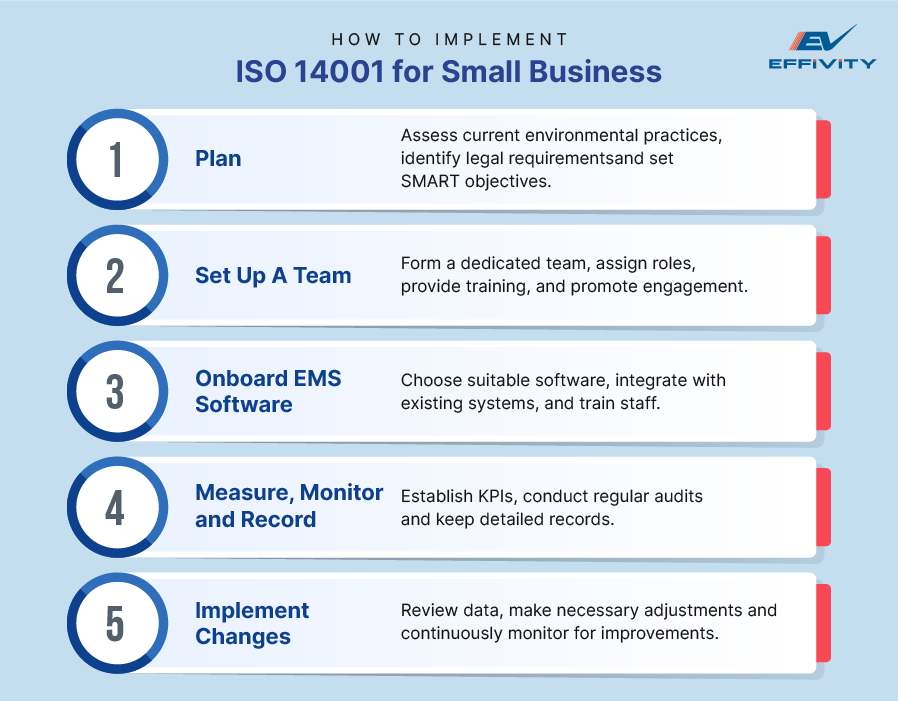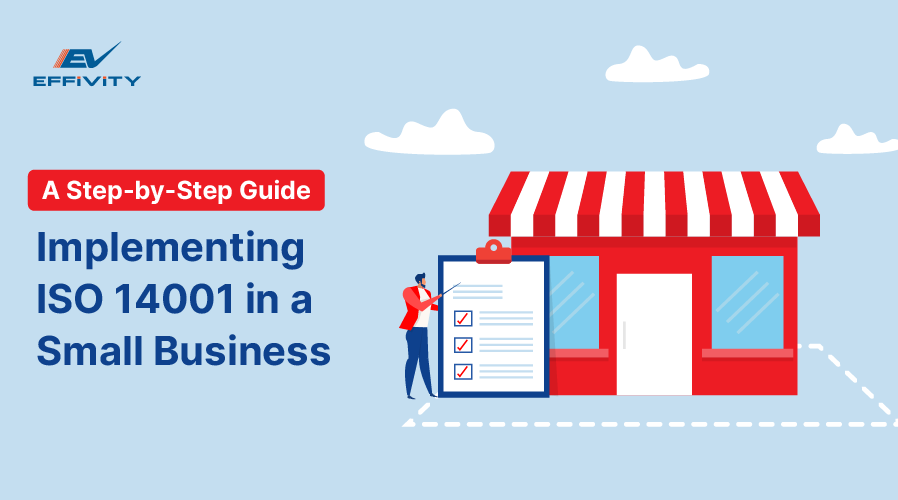Today, businesses, small and large, are expected to commit to the environment and sustainability. Customers and stakeholders often prefer an organization that is environmentally responsible.
Implementing ISO 14001 in a small business can present many challenges. This is often due to small businesses' limitations in terms of resources and available mechanisms. However, with the proper steps and tools, implementing ISO 14001 can be made more accessible and practical for small businesses.
In this article, we explore the common challenges, how you can implement the standard successfully, potential benefits and how an Environment Management System Software can simplify the process.
Challenges with ISO 14001 Implementation in Small Business
While small businesses can greatly benefit from implementing environmental standards in terms of saving on costs and fines related to environmental breaches. However, small businesses also face challenges with implementation due to limited resources and personnel. Some common challenges include:
1. Cost
One of the first hurdles that small businesses must overcome is the cost of implementing ISO 14001. Costs begin to add up quickly starting from the cost for initial assessments by consultants, to purchasing, and setting up essential software and equipment.
The business may also have to purchase sustainable materials, which are generally more expensive. Apart from these costs, implementing ISO 14001 also means conducting regular external audits and getting certifications; these can add up to ongoing costs.
2. Time
The ISO 14001 implementation process can be time consuming, especially when small businesses do not have personnel who can handle the process. Implementing the standard would need an overhaul of existing systems which can take time to establish.
The documentation needed for recording processes, procedures and records can be time-consuming to maintain and update.
3. Complexity
The complexity of ISO 14001 can be daunting for small businesses due to its detailed requirements and guidelines. Without prior experience, understanding and implementing these standards can be difficult, as many small businesses lack the necessary expertise.
Integrating ISO 14001 with existing management systems adds another layer of complexity, often requiring significant adjustments and coordination. Tailoring the standard to fit specific business operations further complicates the process.
How to Implement ISO 14001 for Small Business?
Let us look at how to implement the ISO 14001 standard in your small business to uphold your environmental responsibility successfully.

1. Plan
To implement ISO 14001 you have to start with a plan.
-
Examine Current Practices:
Perform a thorough assessment of your current environmental practices to identify areas where improvements are needed. -
Identify Legal Requirements:
Research and document all relevant environmental legislations, regulations and laws that apply to your business. -
Set Objectives and Targets:
Based on your assessment, set SMART environmental objectives. These could include reducing waste, cutting energy consumption, or improving recycling rates.
2. Set Up a Team
Forming a dedicated team is essential for the successful implementation of ISO 14001. This team shall be in-charge for overseeing the EMS and ensuring that it is integrated into all aspects of your business.
-
Assign Roles and Responsibilities:
Designate team members with specific responsibilities related to the EMS. This could include roles such as environmental coordinator, compliance officer, and data manager. -
Provide Training:
Ensure that your team is well-versed in ISO 14001 requirements and environmental management principles. This may involve formal training sessions, workshops, or bringing in external consultants. -
Promote Engagement:
Encourage collaboration and communication across all levels of your organization. Every employee should understand their role in achieving the environmental objectives set out by the EMS.
3. Onboard An EMS Software
To streamline the implementation process, consider onboarding an Environmental Management System (EMS) software. This software can help you manage documentation, track progress, and ensure compliance with ISO 14001 requirements.
-
Select the Right Software:
Choose an EMS software that suits the size and needs of your business. Look for features such as document management, compliance tracking, and reporting capabilities. -
Integrate with Existing Systems:
Ensure that the EMS software integrates effortlessly with your existing business systems like your project management or accounting software. -
Train Staff:
Instruct your staff on how to use the EMS software effectively. This will help them navigate the system, input data accurately, and generate reports as needed.
4. Measure, Monitor, and Record
Once your EMS is in place, it's essential to measure, monitor, and record your environmental performance regularly. This step is critical for identifying areas where improvements can be made and ensuring ongoing compliance with ISO 14001.
-
Establish Key Performance Indicators (KPIs):
Define KPIs that align with your environmental objectives. These might include metrics like energy usage, waste reduction, or water conservation. -
Conduct Regular Audits:
Perform internal audits to assess the effectiveness of your EMS and identify any gaps in compliance. Regular audits help ensure that your system remains effective over time. -
Record and Report:
Keep detailed records of your environmental performance and any actions taken to improve it. Use these records to generate reports for management review and external audits.
5. Implement Changes
Improvement is a foundational principle of ISO 14001. Based on the data gathered from monitoring and audits, implement changes to enhance your environmental performance.
-
Review and Analyze Data:
Regularly review the data collected from your monitoring activities. Analyze this data to spot trends, successes, and areas where further improvements are needed. -
Make Necessary Adjustments:
Implement changes based on your analysis. This could involve updating processes, investing in new technologies, or revising your environmental objectives. -
Evaluate and Repeat:
After implementing changes, continue to monitor and evaluate their effectiveness. This ongoing cycle of review and improvement is key to maintaining ISO 14001 certification and achieving long-term environmental goals.
Benefits of ISO 14001 Standard for Small Business
Implementing ISO 14001 offers significant advantages for small businesses, enhancing both their operations and reputation. The key benefits include:
1. Cost Savings
ISO 14001 helps small businesses reduce costs by improving resource efficiency. By implementing waste reduction strategies and optimizing energy usage, businesses can lower operational expenses.
For example, better waste management can lead to reduced disposal costs, while energy-saving practices decrease utility bills.
2. Compliance with Regulations
Staying compliant with environmental regulations is crucial, and ISO 14001 provides a structured approach to meeting these requirements. The standard ensures that businesses stay up to date with legal obligations and reduces the risk of fines and penalties.
3. Improved Marketability
Achieving ISO 14001 certification can enhance a small business's marketability. Customers and stakeholders increasingly prefer to engage with environmentally responsible companies.
Certification offers tangible proof of your dedication to sustainability, which can differentiate your business from competitors and attract more clients who prioritize eco-friendly practices.
4. Employee Engagement and Morale
ISO 14001 fosters a culture of environmental responsibility within the organization. When employees see that their company is committed to reducing its environmental impact, it can boost morale and increase engagement.
Engaged and active employees are often more productive and loyal, contributing positively to the overall success of the business.
Final Thoughts
Implementing the ISO 14001 standard can be a valuable investment for SMEs looking to improve efficiency and compliance. The right Environment Management System Software can make implementing the ISO standard easier and faster. Effivity's EMS software offers a customizable and scalable software solution to improve your organization's environmental commitment.






























